You thought 2019 was quite the busy sailing year in Ireland? Believe me folks, after writing last Saturday’s marathon review of one very special season, we went through the weekend in a state of mental meltdown which wasn’t helped by knowing that this weekend would naturally require an anticipation of what’s coming down the line in 2020.
But the fates are kind. So much is going to be happening afloat and ashore in the sailing and boating context in 2020 that reinforcements will be available at every juncture to look after details. So today’s piece is in the very broad strokes category rather than delving into the minutiae, giving some sense of what it will be like to live through the various special occasions and events which are going to be fired at us from nearly every Irish sailing centre.
Yet no matter which way you look at it, the Tricentenary of the Royal Cork Yacht Club is the beginning, the middle and the end of everything that will be happening in Irish sailing in 2020. Three hundred years. Three hundred? Is it something that we really grasp in any meaningful way?
Oh for sure, the latest global genetic research suggests that the first true ancestors of Homo Sapiens first appeared 200,000 years ago, living blissfully beside a large and verdant lake in the midst of what is now the Kalahari Desert in southern Africa. Evidently, in those days climate change was already past its infancy, but it’s the certainty of those 200,000 years which give pause for thought. Set against that, and the age of Newgrange or the Pyramids or other inert ancient monuments, and the 300 years of Cork sailing isn’t even the blink of an eye.
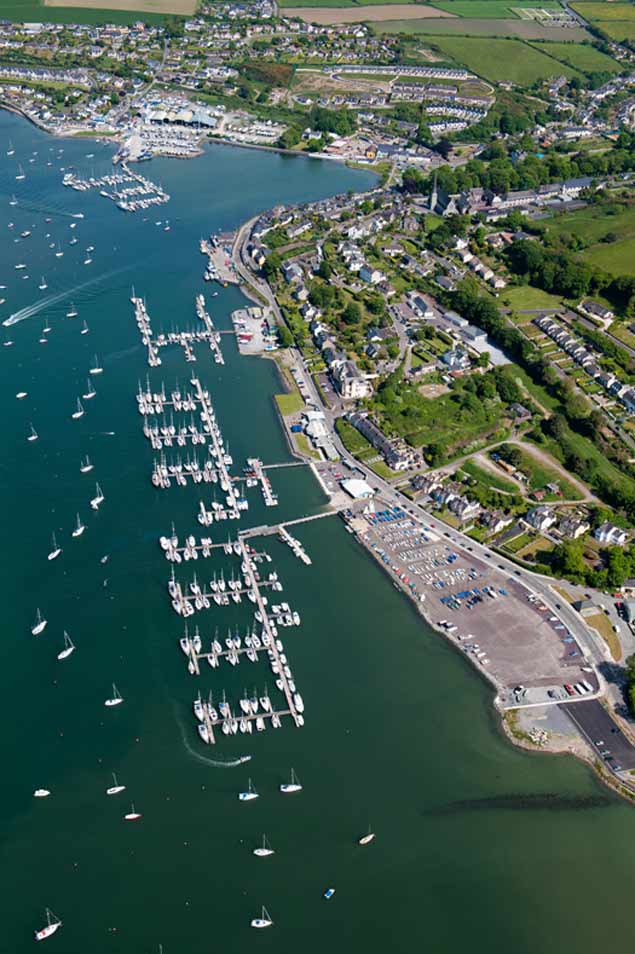 Recreational sailing from Cork Harbour may have had several different locations for its main focal point over the centuries. But the one true flame of the spirit of sailing has burned throughout, and is very much alive and well at today’s Royal Cork YC headquarters at Crosshaven. Photo: Robert Bateman
Recreational sailing from Cork Harbour may have had several different locations for its main focal point over the centuries. But the one true flame of the spirit of sailing has burned throughout, and is very much alive and well at today’s Royal Cork YC headquarters at Crosshaven. Photo: Robert Bateman
But the Royal Cork Yacht Club is still very much alive and relevant to life in 2020. It may have moved its location from time to time in Cork Harbour, and it may have started life as the Water Club of the Harbour of Cork in 1720. But through these mutations, and through times of widely varying prosperity, the spirit - the vital spark of the club - has never been extinguished. In 2020, we’re going to have to grasp just what 300 years really mean in truly human everyday terms, because it’s likely that most of us – other than historians, archaeologists or whatever – think that the average human lifespan is probably the most comprehensible unit of historic time measurement, and anything beyond that is just so ancient as not to be thought about at all.
Fortunately, we have a very solid foundation on which to assess the story of Cork and world sailing. In 2005, the Royal Cork Yacht Club published its full history, based on its extensive and ancient archives which had been in the dedicated voluntary care of Dermot Burns for some time, and they got professional historian Alicia St Leger to make sense of it. The result of it all – so beautifully designed and produced by Tony O’Hanlon that it won national book and printing awards - was one massive and weighty tome.
We’re talking of a mighty volume 33cm (1ft 1in) x 24cm (9.5ins) and 5 cm (2ins) deep, weighing 6.75 lbs (3.1kg), with 480 pages and more images, illustrations and photos than you could count, every one of them an historic gem set in a book of breath-taking beauty For some readers, its sheer size is daunting. It’s definitely serious desk reading. But every page provides something of pure gold, and if you want a genuine sense of what 300 years is really like in a way to which sailing folk can relate, it is required reading, while also being a treasure trove of information which, in 2020 with its special celebrations, is more important than ever.
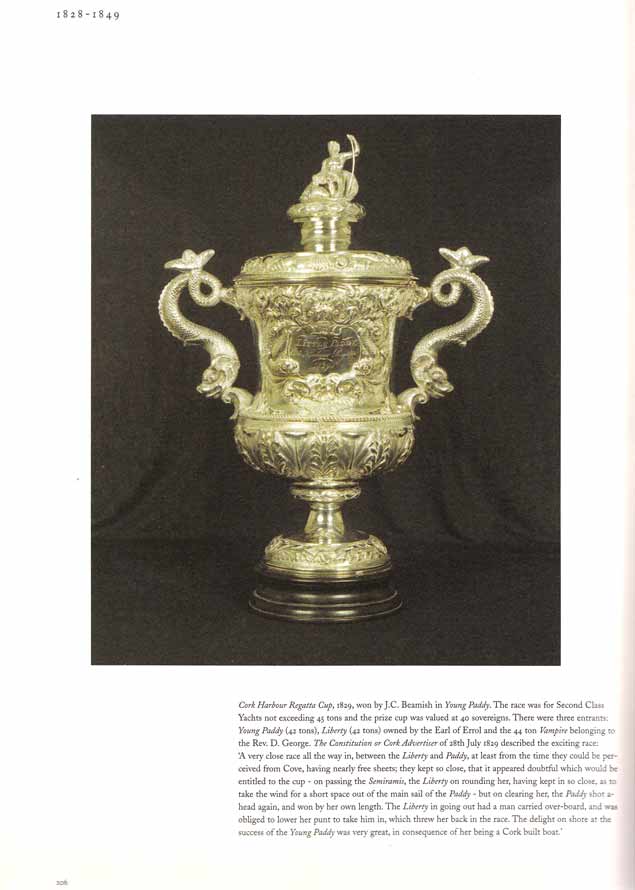 This typical page from the Royal Cork Yacht Club History - published 2005 - gives the detailed story of the 1829 Cork Harbour Regatta Cup (now in the club’s collection), which was won by Caulfield Beamish’s 42-ton cutter Young Paddy by a boat’s length. It was a very popular victory, as the boat – which achieved additional success elsewhere - was owner-designed and built locally on the shores of Cork Harbour. Reproduced by courtesy RCYC
This typical page from the Royal Cork Yacht Club History - published 2005 - gives the detailed story of the 1829 Cork Harbour Regatta Cup (now in the club’s collection), which was won by Caulfield Beamish’s 42-ton cutter Young Paddy by a boat’s length. It was a very popular victory, as the boat – which achieved additional success elsewhere - was owner-designed and built locally on the shores of Cork Harbour. Reproduced by courtesy RCYC
Thus the book, nearly 15 years after its publication, continues to be an enormous credit to the Flag Officers, Committee, support volunteers and production team who created this priceless record with the full support of the membership of a club which is - in numerical terms of those living within everyday reach and actively involved – really quite a modest outfit, even if its very distinguished overseas membership significantly boosts the numbers.
So we’ll return to the History of the Royal Cork YC in due course today as we close in on July 2020, when global sailing and international powerboating fixes its focus firmly on Cork Harbour. That said, anyone coming to Ireland simply for the Cork festivities has it easy from the logistic points of view, as they’re thinking of just one thing in one month in the one place. Yet those of who actually live in Ireland in what we hope will be a summery place for the season that’s in it will have to work our way through a programme which would be quite busy even if the Royal Cork’s Megafest weren’t taking place.
These are some of the building blocks of the year in which this Tricentenary is taking place. In 2020:
- Lough Ree Yacht Club is 250 years old.
- Lough Erne YC is 200.
- Howth Yacht Club is 125.
- The Round Ireland Race from Wicklow on June 20th (now sponsored by SSE Renewables) celebrates its 40th Anniversary.
- The GP14 Worlds are in Skerries from 25th to 31st July
- The International Fireball Worlds take place at Howth from 5th to 14th August
- The International Dragon Gold Cup is at Kinsale from 5th to 11th September
All the clubs with special celebrations will be looking for their place in the sun during 2020 while deferring to the Royal Cork’s unique and deservedly exalted status. And those clubs are also going to have to build any special happenings around the established pillar events which structure the season for cruiser-racers and occasionally One Design classes.
These include the Scottish Series from May 21st to 25th, the biennial Wave Regatta at Howth from Friday May 29th to Sunday May 31st, the developing season-long 2020 ISORA programme as the summer (we hope) takes hold, the SSE Renewables Round Ireland Race from Wicklow on June 20th, and the Bangor Town Regatta on Belfast Lough from 25th to 28th June, which will include the Sigma 33 Championship.
On top of that, 2020 is an Olympic Year, and with some good fortune Ireland will have a national place in the 49er class to add to the Laser Radial placed already secured in Tokyo by the time the Sailing Olympiad gets going at Enoshima in Japan from 27th July to the 6th August. That said, if we don’t get a direct skiff place, there’s a better-than-vicarious participation through Saskia Tidey of the Royal Irish YC, who has teamed up to secure a place in the 49er FX on the British squad with Charlotte Dobson of Scotland.
Meanwhile, back home the much-enjoyed Calves Week in West Cork swings into action with its proven success of a four day format starting at Schull on Tuesday August 4th. And though Cork Harbour in August will not be at quite the same white heart of energy it expended during July, RCYC will be staging at least three more national events in August with an emphasis on smaller boats, with the Open Championships for the National 18s, the Lasers and the Optimists.
 The latest version of the National 18s undergoing evaluation in Cork Harbour, which played a leading role in their introduction. The class will be holding their Annual Championship in August at Crosshaven as part of the RCYC Tricentennial celebrations. Photo: Robert Bateman
The latest version of the National 18s undergoing evaluation in Cork Harbour, which played a leading role in their introduction. The class will be holding their Annual Championship in August at Crosshaven as part of the RCYC Tricentennial celebrations. Photo: Robert Bateman
All three have special associations with RCYC, with the latest version of the National 18s, in particular, being more or less a home-grown (and club-financed) RCYC project, while the Optimist Opens in 2019 saw a Crosshaven/Kinsale winner in James Dwyer Matthews, though the class’s upper age limits will mean a new name on the title in 2020.
Yet as Dwyer Matthews won the 2019 series at Howth in the final race in a total fleet of 185 boats which included participants from 11 nations, the remarkable International Optimist Dinghy Association of Ireland is likely to be looking to honour the Royal Cork YC’s Tricentenary in its own way with a total fleet of more than 200 and even more international participation, for all that it’s a national open championship.
By the time those stratospheric numbers have been achieved, the frenetic pace of July 2020 in Crosshaven, as steadily brought together by Colin Morehead and his Cork300 Committee, will have become the latest chapter in the RCYC’s colourful history, and the basis of it is provided in the incomparable book of the club history.
A new chapter has already been added with the unique twinning of the Royal Cork YC with the Yacht Club de Monaco, and the recent international launching of the Tricentenary by Prince Albert II of Monaco in the YCM clubhouse. In sailing terms, the 300 years of the Royal Cork is quite something, but in absolute terms it pales somewhat when set against the 624 years that have seen he Grimaldi family holding sway as the Princes of Monaco, where they have been the ultimate stakeholders since 1395. There probably wasn’t a lot of recreational sailing going on in Ireland at that time…….
 Colin Morehead, Chairman of Cork300, Prince Albert II of Monaco, and RCYC Admiral Pat Farnan at the recent launching of Cork300 in the Yacht Club de Monaco, which has a unique twinning arrangement with the RCYC, and will be giving its full support to the Tricentenary Celebrations.
Colin Morehead, Chairman of Cork300, Prince Albert II of Monaco, and RCYC Admiral Pat Farnan at the recent launching of Cork300 in the Yacht Club de Monaco, which has a unique twinning arrangement with the RCYC, and will be giving its full support to the Tricentenary Celebrations.
Much is being made of the fact that the Royal Ocean Racing Club’s annual Morgan Cup Race is going to be from Cowes to Cork on July 8th, with a major trophy being presented by the Prince of Wales. For although Cork’s own Harry Donegan with his famous Gull was one of the participant-founders of the RORC after the first 1925 Fastnet Race with Gull third overall, while the new club continued to use the Fastnet Rock as a mark of that course, the first RORC Cowes to Cork race didn’t occur until 1954, when the winner in some decidedly heavy weather was Adlard Coles’ Nicholson yawl Cohoe II, while second overall was Geoffrey Pattinson’s big Robert Clark sloop Jocasta.
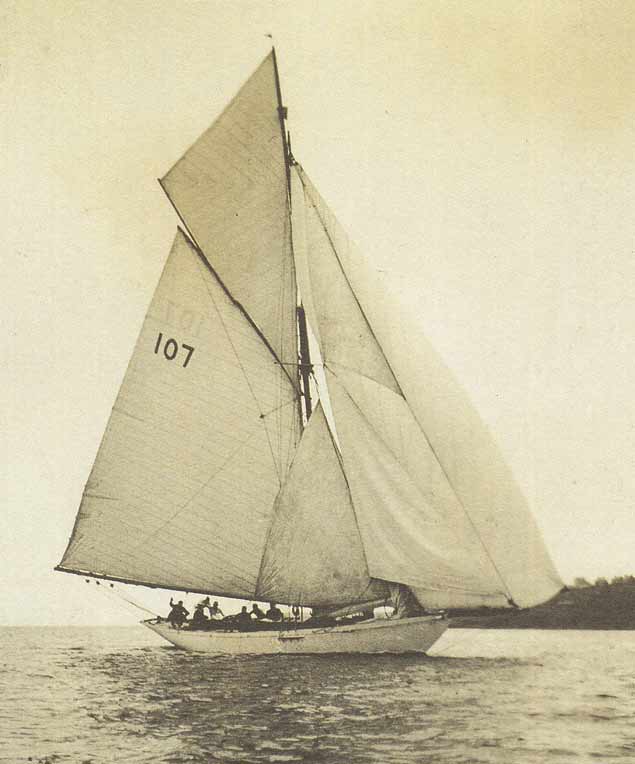 Harry Donegan’s 17-ton cutter Gull of 1898 vintage is one of the most important boats in Cork sailing history. He owned her from 1921 until his death in 1940, and was a founder member of the RORC with participation in the first Fastnet Race of 1925, in which Gull placed third. Gull was also at Glengarriff for the foundation of the Irish Cruising Club in 1929, an event in which Harry Donegan played a central role. As keen for racing as he was for cruising, he was founding Honorary Secretary of the Cork Harbour One Designs from 1895. Photo RCYC
Harry Donegan’s 17-ton cutter Gull of 1898 vintage is one of the most important boats in Cork sailing history. He owned her from 1921 until his death in 1940, and was a founder member of the RORC with participation in the first Fastnet Race of 1925, in which Gull placed third. Gull was also at Glengarriff for the foundation of the Irish Cruising Club in 1929, an event in which Harry Donegan played a central role. As keen for racing as he was for cruising, he was founding Honorary Secretary of the Cork Harbour One Designs from 1895. Photo RCYC
Adlard Coles – best-remembered these days for his book Heavy Weather Sailing - then took Cohoe II for a cruise in southwest Ireland, which is more or less what is planned for the cruising-minded visiting fleets after the mighty Tricentenary Fleet Review in Cork Harbour on Sunday July 12th. The skipper of Cohoe II particularly liked Dingle, at a time when that now-legendary port wasn’t on many cruise plans. But the rest of the RORC couldn’t give up racing, and their next venture was the Cork to Belle Ile Race, which was won by Jocasta.
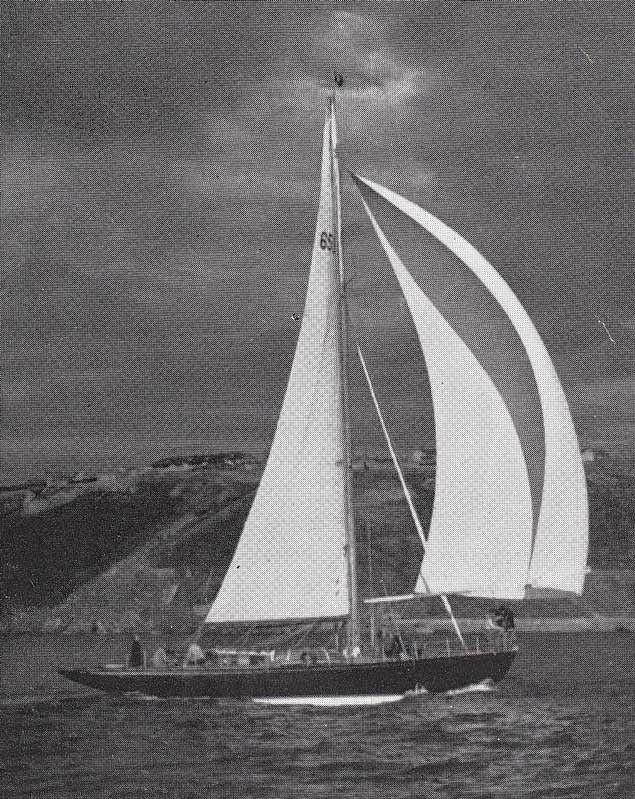 Geoffrey Pattinson’s 55ft Robert Clark-designed alloy sloop Jocasta leaving Cork Harbour at the start of the 1954 RORC Cork-Belle Ile Race, which she won. Jocasta had come to Cork in 1954’s first RORC Cowes-Cork Race, which is going to be repeated in the RORC Morgan Cup Race on Wednesday July 8th 2020.
Geoffrey Pattinson’s 55ft Robert Clark-designed alloy sloop Jocasta leaving Cork Harbour at the start of the 1954 RORC Cork-Belle Ile Race, which she won. Jocasta had come to Cork in 1954’s first RORC Cowes-Cork Race, which is going to be repeated in the RORC Morgan Cup Race on Wednesday July 8th 2020.
Subsequently, RORC races terminating in Cork Harbour tended to be from an Irish Sea start, but in 1970 for the Quarter Millennium, they’d a Cowes-Cork Races again, and in 1974 they’d another one, with line honours taken by Eric Tabarly with the 70ft Pen Duick. He made a point of visiting Carrigaloe in the upper harbour where his family’s Fife-designed cutter (the first Pen Duick) was built in 1898, as were several of the still-extant Cork Harbour One Designs, another Fife creation.
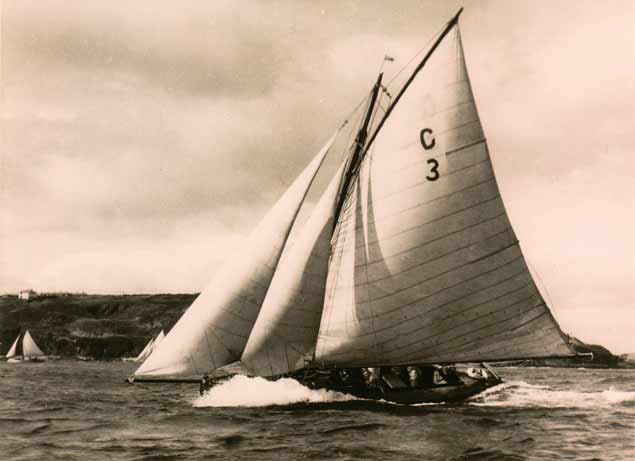 The 1896-built Cork Harbour One Design Imp heading seawards at full power. The 1890s were a notable decade for yacht-building around Cork Harbour Photo Tom Barker
The 1896-built Cork Harbour One Design Imp heading seawards at full power. The 1890s were a notable decade for yacht-building around Cork Harbour Photo Tom Barker
The superbly-sheltered character and much-indented shoreline of Cork Harbour means that – unlike Dublin Bay – there are many places where it has been possible to set up boat-building locations, and over the centuries since the time of the Water Club and beyond, new Cork-created yachts have appeared from these different locations to go on to build national and international reputations, vessels such as Caulfield Beamish’s owner-designed Young Paddy from the late 1820s.
The rush of creativity in the 1890s was typified by Pen Duick, while more recently the hotbed of ideas which was the Cork area in the 1970s to 1990s - when designers such as Ron Holland and Tony Castro, highly skilled boatbuilders like Killian Bushe, and Dick Leonard and his team at Crosshaven Boatyard, together with sailmakers like the McWilliam brothers – put Royal Cork racing achievement central stage.
 Eric Tabarly’s famous 43ft cutter Pen Duick, another creation of the Cork Harbour energy of the 1890s. She was built to a Fife design in Carrigaloe in 1898.
Eric Tabarly’s famous 43ft cutter Pen Duick, another creation of the Cork Harbour energy of the 1890s. She was built to a Fife design in Carrigaloe in 1898.
The emergence of exceptional sailing talents to match these boats - people like Jimmy Payne and his son Somers, Clayton Love Jnr, Ted Crosbie, Harold Cudmore, Denis Doyle, Anthony O’Leary and Mark Mansfield - to name only eight out of a host of greats – is yet another aspect of a story so continuous and complex that its existence is probably the best we can hope to see acknowledged during 2020 when everyone will be busy getting on with celebration afloat and ashore, living in the present while being aware of this remarkable saga of sailing which has made the Royal Cork YC what it is today.
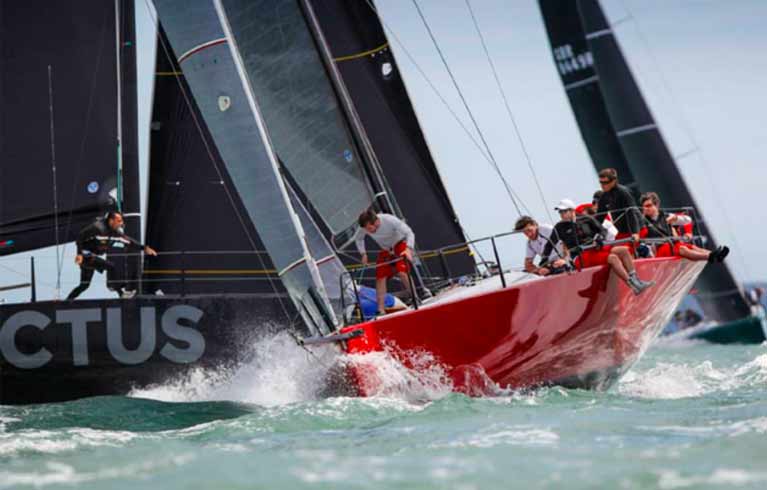 Modern superstar – Anthony O’Leary’s 39ft Antix, RORC Yacht of the Year in 2014.
Modern superstar – Anthony O’Leary’s 39ft Antix, RORC Yacht of the Year in 2014.
You’re never far from sailing history like this in Cork Harbour, and it’s way back beyond 1898 that we go for the origins of the other race which will be bringing fleets to Crosshaven, the pioneering 190-mile Dublin Bay to Cork Harbour Race of 14th July 1860, which was probably one of the first recognisably modern offshore races to be staged anywhere in the world.
The original account was in Hunt’s Yachting Magazine in the summer of 1860, subsequently, it appeared in To Sail the Crested Sea, the history of the first fifty years of the Irish Cruising Club published in 1979, and in the RCYC History of 2005 the story is told again – on page 155.
So although some other versions of the finishing order in the fleet of sixteen yachts seem to be circulating at the moment, the records with the RCYC on what became known as the Kingstown-Queenstown Race have it that the winner – finishing off Cobh in the lightest of airs at 5.20 am on the Monday July 16th – was the 39-ton cutter Sibyl, owned by Sir John Arnott and sailed by the renowned amateur skipper Henry O’Bryen, while second just three minutes later was the 80-ton cutter Peri (J W Cannon), and third only two minutes astern at 5.25 am was the 90-ton schooner Kingfisher (Cooper Penrose).
There were no handicap calculations in those pioneering “ocean match” days, so the Sibyl’s win was doubly sweet, as the entry fees were based on tonnage, and as the fourth smallest boat in the race, Sibyl’s payment was only 19 shillings and six pence, whereas the largest racer – the 167-ton schooner Mirage which was well off the pace – had to shell out four pounds three shillings and six pence for the doubtful pleasure of being beaten boat-for-boat by a vessel a quarter of her size.
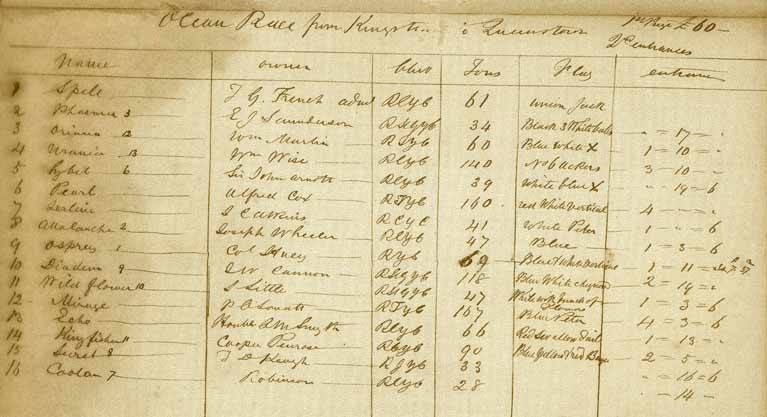 The original entry listing for the first 190-mile Kingstown-Queenstown Race of 14th July 1860, including the varied entry fees. The winner – by just three minutes – was the 39-ton Sybil, listed No 6, owned by Sir John Arnott and sailed by renowned amateur skipper Henry O’Bryen. Courtesy RCYC
The original entry listing for the first 190-mile Kingstown-Queenstown Race of 14th July 1860, including the varied entry fees. The winner – by just three minutes – was the 39-ton Sybil, listed No 6, owned by Sir John Arnott and sailed by renowned amateur skipper Henry O’Bryen. Courtesy RCYC
That Henry O’Bryen was able to find the last few minutes of concentration to take a win was quite something when – as the Hunt’s Magazine report put it – “the excitement was painfully intense”, for the ace amateur had spent the entire race on deck, and reportedly nearly always on the helm. As the Kingstown-Queenstown Race is going to be sailed again on July 9th 2020 to bring the Irish Sea fleets to the Tricentenary, by the time the fleets converge for the Review of July 12th, his achievements will be even better appreciated.
Once the Review has been completed, Volvo Cork Week 2020 gets underway on Monday July 13th, and includes the ICRA Nats and the European IRC Championship. But with demands on boats being at such a height, the Inter-services Racing for the Beaufort Cup, won by Commandant Barry Byrne and the Defence Forces crew in 2016 and 2018, is currently scheduled to be staged on Monday 20th July.
Meanwhile, the many cruisers which have been assembling will be heading west in a cruising tradition which is probably as old as the Royal Cork itself, and certainly was very central to the two-year Quarter Millennial celebrations in 1969-70. With Volvo Cork Week in full swing in and off the harbour, the pace will be different, but we can expect the RCYC to take it all in its stride, as they have been doing for three hundred years.
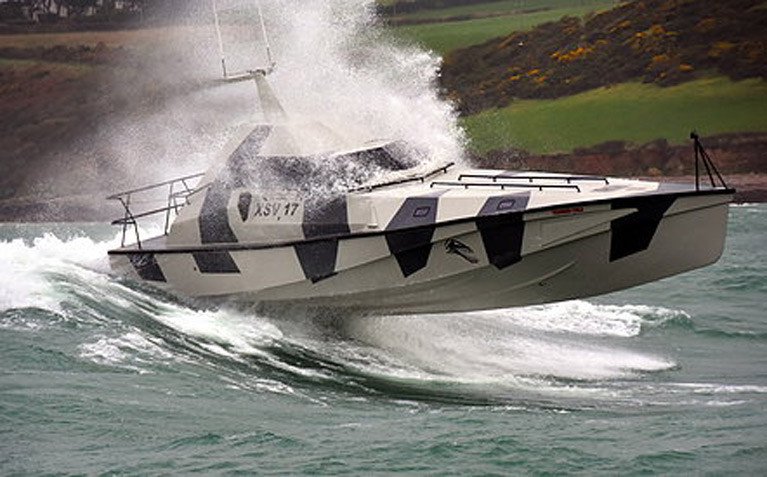 The offshore powerboat Thunder Child, a project of Safehaven Marine led by Frank Kowalski, holds the Round Ireland & Rockall Record. The Cork300 programme will include a Powerboat Festival featuring a race to the Fastnet Rock and back to Cork Harbour.
The offshore powerboat Thunder Child, a project of Safehaven Marine led by Frank Kowalski, holds the Round Ireland & Rockall Record. The Cork300 programme will include a Powerboat Festival featuring a race to the Fastnet Rock and back to Cork Harbour.
And included somewhere in all this will be a major powerboat race. John Ryan of County Wicklow and Frank Kowalski of Safehaven Marine in Youghal have been upping the ante on serious offshore powerboat records with an Irish connection in recent years, and most appropriately the Royal Cork is the custodian of a trophy for the fastest powerboat time from Cork Harbour to the Fastnet Rock and back.
It’s appropriate because, somewhere at the heart of the current Royal Cork clubhouse building complex, there’s what was originally the 1923-built Cork Motor-Boat Club designed by architect Jim Buchan. They’d no sooner got it built than sailing types began moving in, then the Royal Munster YC from Monkstown moved down and took over, and then in 1967 the Royal Cork from its old base in Cobh moved across harbour for a reverse takeover of the Royal Munster in which, in due course, the Royal Munster was swallowed completely, with Crosshaven now home to the Royal Cork Yacht Club.
 Architect Jim Buchan’s design for the Cork Harbour Motorboat Club at Crosshaven in 1923, which was quickly absorbed into the Royal Munster YC and enlarged, and then further enlarged after the RMYC was amalgamated with the Royal Cork YC in 1967.
Architect Jim Buchan’s design for the Cork Harbour Motorboat Club at Crosshaven in 1923, which was quickly absorbed into the Royal Munster YC and enlarged, and then further enlarged after the RMYC was amalgamated with the Royal Cork YC in 1967.
But what goes round comes round. Those motor-boaters of 1923 will be remembered. The accessibility theme which Colin Morehead and his team have been taking as the core of their Tricentenary programme has a very positive attitude towards grown-up powerboat racing, and another main event around a Powerboat Festival on 11th July will be a race to the Fastnet, and maybe on to the Skelligs as well. After three hundred years, if the RCYC think it might be worth giving it a whirl, a whirl is what it will get.
The programme is being adjusted to take account of boat availability realities, but at the moment the basic form in Cork Harbour is:
- Friday 3rd July-Sunday 5th July: Seafest
- Saturday 4th July-Tuesday 7th July: Feeder Cruises arrival
- Saturday 4th July-11th July: Water Club Cup (Inter-club, 1720 Sportsboats)
- Tuesday 7th July-Saturday 11th July:
- Cruise Fest: Fleet/Class/Gatherings; Classic & Supperyacht Gatherings; Traditional Boat Gathering: Naval Gathering; Harbour Support Events; Feeder Races Arrivals.
- Saturday July 11th: Powerboat Festival
- Sunday 12th July: Fleet Review (all boats)
- Monday July 13th Cruises in company depart
- Monday July 13th – Friday July 17th Volvo Cork Week including ICRA Nats.
- Saturday July 18th – Saturday July 25th: Glandore Classic Regatta
- Monday July 20th Beaufort Cup
- August – Championship Weeks back-to-back for National 18s, Lasers and Optimists
As we said at the beginning, this is only a very broad strokes outline stage – precision is emerging with every passing day. And as Autumn 2020 takes over, we hope that somebody remembers that, back in 1970 to round out the Quarter Millennium, the Royal Cork staged the annual Helmsman’s Championship, as it then was. Of the six finalists, five are still happily with us – Harold Cudmore, Maurice Butler, Owen Delaney, Michael O’Rahilly and the winner, Robert Dix. With the Royal Cork finally winding down a little after this Year of Years, some sort of Golden Jubilee event for them in the conclusion of Tricentennial Celebrations surely could be fitted in?
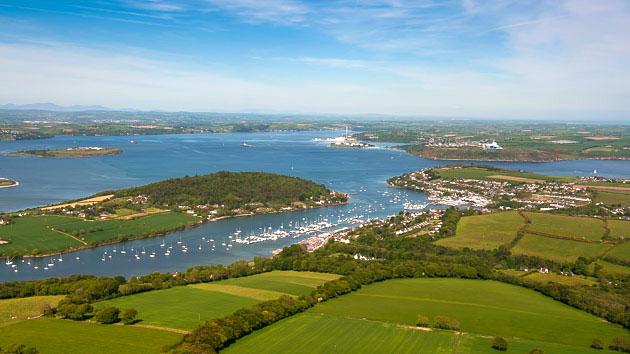 Crosshaven, home of the Royal Cork Yacht Club. Could there be a more natural place to enjoy sailing? Set among green fields in a friendly village with a commodious yet sheltered harbour immediately accessible, and an interesting coastline on open sea within easy reach – Crosshaven has it all.
Crosshaven, home of the Royal Cork Yacht Club. Could there be a more natural place to enjoy sailing? Set among green fields in a friendly village with a commodious yet sheltered harbour immediately accessible, and an interesting coastline on open sea within easy reach – Crosshaven has it all.
































































